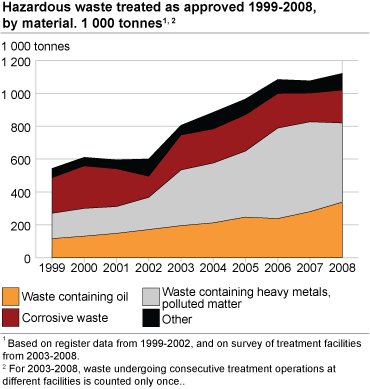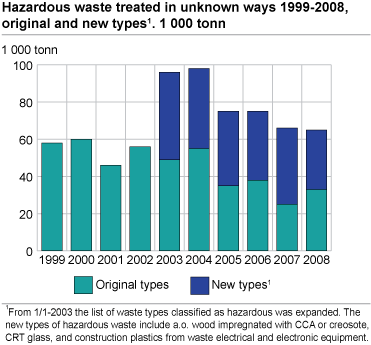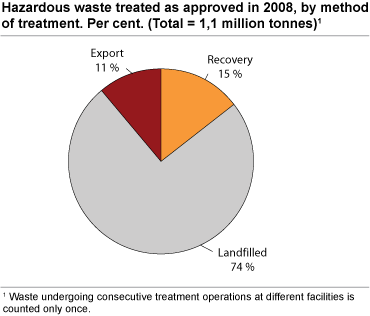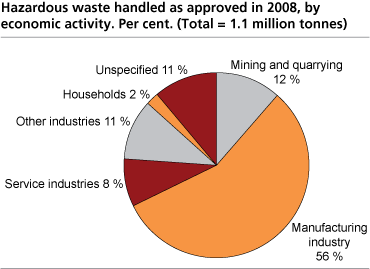Content
Published:
This is an archived release.
Reduced growth in collected hazardous waste amount
The amount of hazardous waste being collected for approved treatment in 2008 reached 1.1 million tonnes, after a 3.5 per cent growth since 2006. From 1999, however, the amount has more than doubled. Improved collection and reporting are believed to be the main causes.
A certain growth in generated hazardous waste amounts is also believed to have taken place, in line with the economical growth. It is a political target to limit the generation of hazardous waste, in order to reduce the risk of emitting pollutants to the environment.
The most abundant waste types were waste with heavy metals and polluted mineral matter. This waste category covered 482 000 tonnes in 2008, or 43 per cent of all hazardous waste going to approved treatment. Oil-containing waste follows with a 30 per cent share, while 18 per cent was corrosive waste, mainly thin acid. The amount of oil-containing waste being treated as approved increased by 100 000 tonnes from 2006 to 2008, which represents a 42 per cent growth in 2 years. In the same period, the amount of waste with heavy metals and polluted matter declined by 69 000 tonnes, or 12 per cent. The decline is mainly due to the cleaning of heavily polluted industrial areas in 2006 and 2007, giving rise to huge amounts of hazardous polluted matter in these years.
The statistics do not regard the hazardous substances as differing in concentration and toxicity. Accordingly, waste types contributing insignificantly to the total amounts may be highly relevant from an environmental point of view. This includes waste with PCB, lead accumulators and waste with mercury, which have collected amounts of 2 900 tonnes, 27 000 tonnes and 640 tonnes respectively.
Falling amounts to unknown handling
Statistics Norway estimates how much hazardous waste goes to unknown handling, which means the waste is not registered as delivered to an approved treatment facility. These estimations are somewhat uncertain and may be incomplete. Still, the estimates indicate an equal amount going to unknown handling in 2008 and 2007, but a long-term decline of 32 per cent from 2003 to 2008. This decline is mainly caused by increased collection of oil-containing waste and falling amounts of discarded creosote-impregnated wood.
Due to changes in legislation, several waste types were regarded hazardous from 2003, including impregnated wood, eternit (asbestos cement) and plastics with brominated flame retardants. The amount of such new types of hazardous waste registered to approved treatment in 2008 was 40 000 tonnes. This is twice as much as in 2003. In the same period, the amount going to unknown handling dropped by a third, to 32 000 tonnes. The changes in legislation cause a break in the time series.
The unknown handling of original hazardous waste types not affected by the legislation changes amounted to 33 000 tonnes in 2008. The long-term trend is a decline here as well, by 43 per cent since 1999, despite an 8 000 tonne drop last year. Oil-containing waste, such as waste oil, sludge from cleaning of tanks and slop water from ships, has made up around four fifths of the original waste types going to unknown handling during the period.
Short-term variation in the amount of hazardous waste going to unknown handling is assumed to be mainly caused by stock changes, while the long-term decline is a result of increased collection.
The main part is treated in Norway
Nearly 90 per cent, or 997 000 tonnes, of the hazardous waste being treated as approved in 2008, was treated in Norway. The remaining 123 000 tonnes was exported for treatment abroad. In total, 23 per cent of the hazardous waste was recovered, i.e. recycled or energy recovered, while the remainder was disposed of, mainly on landfills. Treatment abroad is included. In 2007, 16 per cent of the hazardous waste was recovered.
Export of hazardous waste is regulated by international law, and is allowed only if national treatment capacity is insufficient or the waste is sent for recovery. The Norwegian authorities aim at reducing the export of hazardous waste, a.o. by ensuring national treatment capacity. However, the export of hazardous waste nearly doubled from 2007 to 2008. The exported waste was mainly recycled (60 per cent), while 13 per cent was energy recovered and 27 per cent was disposed of.
A total of 236 000 tonnes of hazardous waste was also imported to Norway, representing 19 per cent of all hazardous waste treated at Norwegian facilities. Thirty-six per cent of the imported amount was either recycled or energy recovered.
The big amounts come from manufacturing
The manufacturing industries delivered 632 000 tonnes of hazardous waste to approved treatment in 2008, including internal treatment. This makes up 56 per cent of all hazardous waste treated as approved this year, or 63 per cent when excluding waste from unknown economic activity. The manufacturing also represented the highest growth in hazardous waste amounts expressed in tonnes, by 87 000 tonnes. However, the growth was even bigger in other industries in terms of per cent. On the contrary, the mining and quarrying and the construction and demolition industries showed a 12 and 20 per cent decline respectively, to 130 000 and 13 000 tonnes in 2008. This breaks the 2003 to 2007 increase for those industries.
The households delivered 27 000 tonnes of hazardous waste to approved treatment in 2008, which is up 28 per cent from the previous year. The development is due to an increased delivery of impregnated wood. In addition, the households deliver significant amounts of electrical and electronic waste, such as white goods and mobile phones, to the distributors when buying new goods, or to waste collectors. Such waste is not classified as hazardous waste in Norway, but contains hazardous components and must be delivered separately.
Hazardous wasteHazardous waste contains substances that may be harmful to human health and the environment. Consequently, there are strict regulations concerning the delivery and treatment of such waste. Moreover, international law puts limits to the export of such waste. Post-revisionPost-revision of the basic data for 2007 and 2006 has lead to a 5 per cent increase and a 2 per cent decrease respectively in amounts going to approved treatment, compared to the previous release. |
Tables:
- Table 1 Hazardous waste treated as approved 1999 to 2008, by material. 1 000 tonnes.
- Table 2 Hazardous waste treated as approved and handled in unknown ways in 1999 to 2008, total and new types . 1 000 tonnes.
- Table 3 Hazardous waste to unknown handling 1999 to 2008, by material. 1 000 tonnes.
- Table 4 Hazardous waste treated as approved 2003 to 2008, by method of treatment. 1 000 tonnes.
- Table 5 Hazardous waste treated as approved 1999 to 2008, by economic activity. 1 000 tonnes.
Additional information
Approved treatment as applied in this article includes only hazardous waste generated in Norway (export is therefore included, while import is excluded).
Contact
-
Gisle Berge
E-mail: gisle.berge@ssb.no
tel.: (+47) 48 12 19 97
-
Terje Lorentzen Landsem
E-mail: terje.landsem@ssb.no
tel.: (+47) 98 84 31 39




